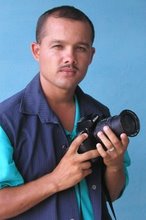The Franciscan fray Antonio de Alegría started the pilgrimage tradition in Holguín in 1790. The Hermanos Saíz Association (AHS), the juvenile organization of the artistic vanguard of the Island, and students of the university of Holguín, re-vindicates the May Pilgrimage a little more than two centuries later in a secularization process whose motto, left behind by the Holguín scientific Juan Manuel Guash del Monte, was “… because there is not today without yesterday ”.

Then, in the beginning, the festivity was only religious; next it gets a popular tinge. Today it is an artistic melting pot even though culture extended to streets can hardly reveal the few religious services by those who go on a pilgrimage to pay for promises or to worship.
There was not that flight of stairs dying at the top of the Hill of the Cross two centuries ago. It is perhaps a makeshift and a denial to the 
In the beginning the cross was carried all the way up on shoulders and then town people gradually got together in the skirts of the Cerro Bayado, now Hill of the Cross, to dance, to drink rum, to fight rooster. Now people drink, dance and listen to music after the pilgrimage, where fellow country-men and foreigners played a lead role on the streets of the city full of art like the perfect language of consensus.
Although some prefer not to refer to it as a popular party, it really is, but charged significantly with art. The idea conceived by Cuban moviemaker Humberto Solás in the Gibara International Non-Budget Film Festival had already turned out well in the May Pilgrimages: to bring together different arts in a single festival.
Many events within the May Pilgrimages account for it: the event of Dance in Public city-scapes, the street theater, the performance of artists, the Babel Visual Arts event. The film industry with The Blue Chamber, or investigations in the theoretic event Our Memory. Or the Ibero American Handicraft Fair or that sublime trouba gathering at the 
It is a massive and cosmopolitan meeting this year, devoted to 
The May Pilgrimage take a walk between tradition and modernity. Its dynamics has a start in the new part of the city to reach the side where the ritual from Fray Antonio de Alegría was born, inspired in the bible passage related to Constantino the Great’s mother, the Hill of the Cross, but today people carry the Holguín Ax on shoulders instead of the cross to remember so the native population. Transition emerges half the way down the week and gives in to modernity. The ax then comes down the Hill and is hoisted way up over one of the the 18-story building located in the place was the city is younger. In such a great effort organization must be safeguarded so the Pilgrimages can make it longer. The Festival participant number will grow with seriousness and the hope to turn it into a World Festival of Young Artists will be more concrete and plausible.
In such a great effort organization must be safeguarded so the Pilgrimages can make it longer. The Festival participant number will grow with seriousness and the hope to turn it into a World Festival of Young Artists will be more concrete and plausible.
































 The series Life in the Birama Wet Lowland, by JotaCruz, depicts –in excellent compositions, from different angles and in the right moment- different places and species from Birama Wet Lowland at the province of Granma.
The series Life in the Birama Wet Lowland, by JotaCruz, depicts –in excellent compositions, from different angles and in the right moment- different places and species from Birama Wet Lowland at the province of Granma.  Biodiversity, the second rewarded piece by the same creator, approaches, in portraits, endemic birds from the area of Cupeycillo, located at the municipality of Gibara. The photographer feasts on the beauty and charisma of these endemic birds turning the area into a meeting place for scientists, photographers, painters, naturalists and birders.
Biodiversity, the second rewarded piece by the same creator, approaches, in portraits, endemic birds from the area of Cupeycillo, located at the municipality of Gibara. The photographer feasts on the beauty and charisma of these endemic birds turning the area into a meeting place for scientists, photographers, painters, naturalists and birders. The jury board, presided by Nils Navarro and made up besides of photographers Amaurys González and Juan Pablo Carreras, awarded too four Mentions: Carlos Alberto Ferrá for A day after, and to Luis Catalá Gurri, William Lucas Rodríguez and Alexander Sánchez Rivas for their works Hope Nets, The alert spectator and First Steps, respectively.
The jury board, presided by Nils Navarro and made up besides of photographers Amaurys González and Juan Pablo Carreras, awarded too four Mentions: Carlos Alberto Ferrá for A day after, and to Luis Catalá Gurri, William Lucas Rodríguez and Alexander Sánchez Rivas for their works Hope Nets, The alert spectator and First Steps, respectively. It will be open to the public for a month and will be shown next in Gibara during The Community Festival “Protecting Birds” from May 18 to 24 sponsored by several national and international institutions.
It will be open to the public for a month and will be shown next in Gibara during The Community Festival “Protecting Birds” from May 18 to 24 sponsored by several national and international institutions.
















